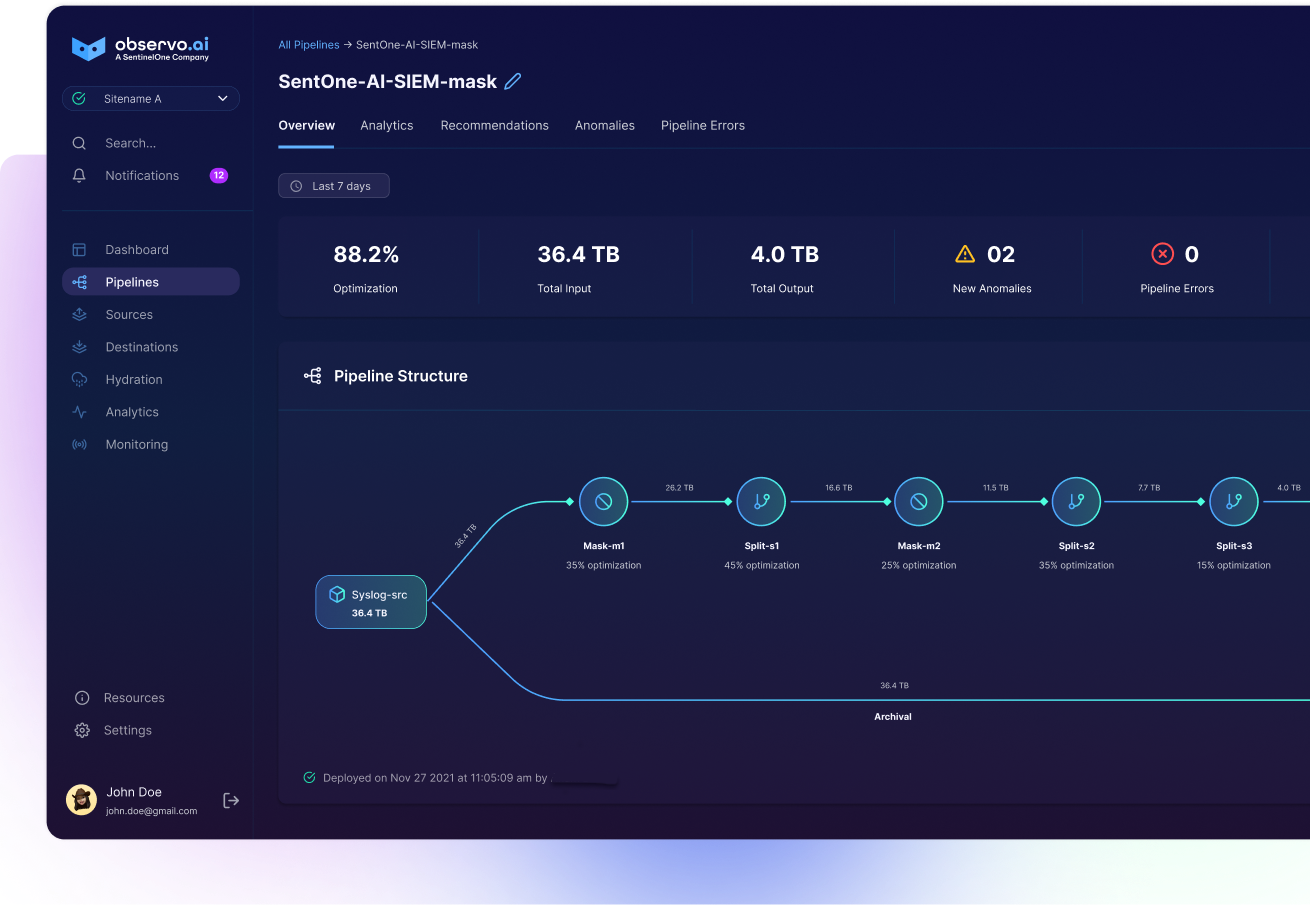Observability 101: What is Parquet File Format

Key Takeaways
- Optimized for Efficiency: Parquet's columnar storage design dramatically enhances data compression and query performance, making it ideal for handling large-scale data workloads efficiently.
- Adaptable Data Schema: With its built-in support for schema evolution, Parquet allows organizations to modify their data structures without disrupting existing processes, ensuring seamless adaptability to evolving data needs.
- Streamlined Data Analysis: By optimizing data storage and retrieval, Parquet enables faster and more effective data analysis, crucial for insights-driven decision-making in observability and other data-intensive fields.
What is Parquet File Format
Parquet is an open-source columnar data file format designed for efficiency. It utilizes diverse encoding and compression schemes tailored to each column, optimizing both storage and rapid retrieval of large volumes of data. This format enhances performance by minimizing storage needs and expediting data access, making it highly effective for bulk data operations.
Introduction
In today's data-driven world, efficiently managing and analyzing vast amounts of data is essential. The choice of file format plays a pivotal role in this process. Parquet, a columnar storage file format, has gained prominence as the go-to format for handling big data workloads. In this comprehensive blog, we'll delve into the Parquet file format, its historical origins, and its advantages. Additionally, we'll explore the vital role that Parquet plays in Observability and how Observo.ai, an AI-powered pipeline, harnesses its capabilities to store telemetry data for seamless querying and analysis.
The Genesis of Parquet: A Historical Overview
Parquet is an open-source columnar storage file format that was born out of a collaboration between multiple tech giants in the big data and analytics space. In 2013, engineers from Twitter, Cloudera, and several other organizations embarked on the mission to create a high-performance, efficient file format that would address the challenges posed by the explosive growth of big data.
The Apache Software Foundation welcomed Parquet into its ecosystem, and it quickly gained traction due to its numerous advantages. Parquet's development was guided by a few key principles:
- Performance: Parquet was designed with performance in mind, especially for analytical queries and data processing workloads. Its columnar storage format enables efficient compression and speeds up data retrieval by reading only the necessary columns.
- Flexibility: Recognizing the need for evolving data schemas, Parquet was designed to support schema evolution. This allows organizations to adapt their data structures over time without rendering historical data obsolete.
- Compatibility: Parquet's format was built to be compatible with a wide range of data processing frameworks and tools, making it a versatile choice for data storage in various domains.
Advantages of the Parquet File Format
Parquet's popularity stems from several key advantages that make it a preferred choice for handling large datasets:
- Columnar Storage: Parquet stores data in a columnar fashion rather than row-based, facilitating better compression and faster query performance. This columnar approach is particularly beneficial for analytical queries involving aggregations and filtering.
- Compression: Parquet employs various compression techniques to minimize storage space, making it a cost-effective solution for storing extensive datasets.
- Schema Evolution: Parquet's support for schema evolution allows organizations to add, remove, or modify columns without the need for a full data rewrite. This flexibility is essential for managing evolving data schemas in Observability pipelines.
- Query Performance: The columnar storage format makes Parquet highly optimized for analytical queries, resulting in faster query performance and improved data retrieval.
The Role of Parquet in Observability
Observability, especially in cloud-based environments, generates massive volumes of telemetry data, including metrics, logs, and events. Efficiently storing and analyzing this data is a significant challenge, and Parquet addresses many of these challenges:
- Efficient Storage: Parquet's columnar storage minimizes storage costs through effective compression and by reading only the necessary columns during queries. This is particularly important for the long-term storage of telemetry data.
- Fast Querying: Observability systems often require complex queries to extract insights from telemetry data. Parquet's columnar structure allows for efficient data retrieval, significantly accelerating query performance.
- Schema Flexibility: Observability data schemas can evolve to accommodate new telemetry sources and types. Parquet's schema evolution support ensures that historical data remains accessible even as the schema changes.
Sample Parquet Data Representation
Here's a simplified example of how telemetry data might be represented in Parquet format:

Parquet File Format Use Cases
The Parquet file format excels in various applications, thanks to its unique features:
- Big Data Processing: Parquet is commonly used in environments like Hadoop and Apache Spark, where its ability to handle massive datasets efficiently is crucial. It reduces I/O operations and accelerates data processing, making it ideal for big data ecosystems.
- Data Warehousing: In data warehousing, Parquet enhances analytical query performance due to its columnar storage format, which allows for better compression and effective partitioning of data. This leads to quicker insights and reduced storage costs.
- Machine Learning: For machine learning applications, Parquet speeds up data ingestion and manipulation. Its efficient structure supports the rapid reading and writing of datasets necessary for training algorithms, significantly optimizing the data preparation phase.
- Cloud Storage and Computing: Parquet's compact file size and efficient data retrieval capabilities make it suitable for cloud environments, where storage and data transfer costs can be optimized while ensuring high performance.
- Interactive Analysis: Its integration with analytical tools like Apache Drill and Tableau facilitates interactive data exploration and visualization, allowing users to perform complex computations and generate reports directly on Parquet-stored data.
Observo.ai: Leveraging Parquet for Telemetry Data
Observo.ai is an AI-driven Observability pipeline that harnesses the power of Parquet for storing telemetry data. Let's take a closer look at how Observo.ai effectively utilizes Parquet:
- Data Ingestion: Observo.ai collects telemetry data from various sources, including cloud environments, applications, and network devices. This data is ingested into the pipeline and transformed into Parquet format.
- Schema Evolution: As new telemetry sources are added or existing ones change, Observo.ai seamlessly adapts the data schema, ensuring compatibility with Parquet's schema evolution capabilities.
- Efficient Storage: Parquet's efficient storage mechanisms allow Observo.ai to store vast amounts of telemetry data cost-effectively, whether for real-time analysis or long-term retention.
- Querying and Analysis: Engineers and technical teams can easily query and analyze telemetry data stored in Parquet format using popular analytical tools and frameworks.
Conclusion
The Parquet file format, with its columnar storage design, efficient compression, and schema flexibility, has become the go-to choice for streaming telemetry data in Observability pipelines. Observo.ai's AI-driven pipeline leverages Parquet to efficiently store, query, and analyze telemetry data, providing engineers and technical teams with the tools they need to gain valuable insights from their data. In the fast-paced world of Observability, Parquet and solutions like Observo.ai are essential for managing and extracting value from telemetry data effectively. The historical journey of Parquet from its collaborative inception to its current prominence underscores its importance in modern data management and analytics.




